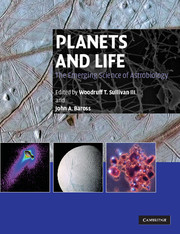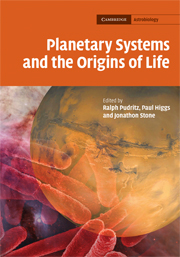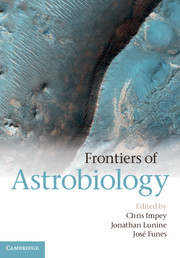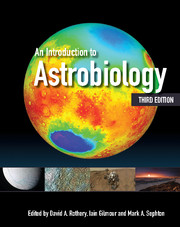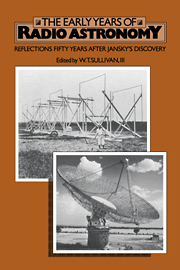Planets and Life
Astrobiology involves the study of the origin and history of life on Earth, planets and moons where life may have arisen, and the search for extraterrestrial life. It combines the sciences of biology, chemistry, palaeontology, geology, planetary physics and astronomy. This textbook brings together world experts in each of these disciplines to provide the most comprehensive coverage of the field currently available. Topics cover the origin and evolution of life on Earth, the geological, physical and chemical conditions in which life might arise and the detection of extraterrestrial life on other planets and moons. The book also covers the history of our ideas on extraterrestrial life and the origin of life, as well as the ethical, philosophical and educational issues raised by astrobiology. Written to be accessible to students from diverse backgrounds, this text will be welcomed by advanced undergraduates and graduates who are taking astrobiology courses.
- Compiled by world experts in their disciplines to create a truly comprehensive book
- Accessible to students from a wide range of backgrounds
- A welcome addition to this rapidly-growing field
Reviews & endorsements
"It's not easy to unify a multidisciplinary field whose main focus (extraterrestrial life) may not exist, but this new astrobiology book pulls it off. Planets and Life is a well-organized compilation of 28 chapters by 50 contributing authors. Coming from such a disparate group of authors, the quality of the writing is surprisingly uniform and high. ... With so many authors and so many topics, the book could have suffered the fate of being a mixed miscellaneous collage, like so many proceeding volumes, but it doesn't. No two authors, or even a small committee of experts, could have presented so many topics at such a high level. ... the combination of details and big picture thinking embodied in this new text will go far to describe our current understanding of how we came to be and how we fit into the universe." - Charles H. Lineweaver, GeoScience World
"Perhaps the book's most impressive achievement is its ability to discuss high-level material over a wide range of disciplines. Drawing on advanced concepts in biology, chemistry, astronomy and even philosophy, Planets and Life effectively provides background for readers whose expertise may lie in a different field. ... Sullivan and Baross do an impressive job of engaging the issues of astrobiology at a high level while keeping the field's guiding questions in full view. ... this book has successfully blazed a trail for the study of astrobiology in university classrooms." - Jeffrey Marlow, Astrobiology Society of Britain
Product details
September 2007Paperback
9780521531023
628 pages
246 × 188 × 36 mm
1.36kg
250 b/w illus. 60 tables
Available
Table of Contents
- Foreword
- Preface
- Contributors
- Prologue
- Part I. History:
- 1. History of astrobiological ideas W. T. Sullivan and D. Carney
- 2. From exobiology to astrobiology S. J. Dick
- Part II. The Physical Stage:
- 3. Formation of Earth-like habitable planets D. E. Brownlee and M. Kress
- 4. Planetary atmospheres and life D. Catling and J. F. Kasting
- Part III. The Origin of Life on Earth:
- 5. Does 'life' have a definition? C.E. Cleland and C. F. Chyba
- 6. Origin of life: crucial issues R. Shapiro
- 7. Origin of proteins and nucleic acids A. Ricardo and S. A. Benner
- 8. The roots of metabolism G.D. Cody and J. H. Scott
- 9. Origin of cellular life D. W. Deamer
- Part IV. Life on Earth:
- 10. Evolution: a defining feature of life J. A. Baross
- 11. Evolution of metabolism and early microbial communities J. A. Leigh, D. A. Stahl and J. T. Staley
- 12. The earliest records of life on Earth R. Buick
- 13. The origin and diversification of eukaryotes M. L. Sogin, D. J. Patterson and A. McArthur
- 14. Limits of carbon life on Earth and elsewhere J. A. Baross, J. Huber and M. Schrenk
- 15. Life in ice J. W. Deming and H. Eicken
- 16. The evolution and diversification of life S. Awramik and K. J. McNamara
- 17. Mass extinctions P. D. Ward
- Part V. Potentially Habitable Worlds:
- 18. Mars B. M. Jakosky, F. Westall and A. Brack
- 19. Europa C. F. Chyba and C. B. Phillips
- 20. Titan J. I. Lunine and B. Rizk
- 21. Extrasolar planets P. Butler
- Part VI. Searching for Extraterrestrial Life:
- 22. How to search for life on other worlds C. P. McKay
- 23. Instruments and strategies for detecting extraterrestrial life P. G. Conrad
- 24. Societial and ethical concerns M. S. Race
- 25. Planetary protection J. D. Rummel
- 26. Searching for extraterrestrial intelligence J. C. Tarter
- 27. Alien biochemistries P. D. Ward and S. A. Benner
- Part VII. Future of the Field:
- 28. Disciplinary and educational opportunities L. Wells, J. Armstrong and J. Huber
- Epilogue C. F. Chyba
- Appendixes: A. Units and usages
- B. Planetary properties
- C. The geological time scale S. Awramik and K. J. McNamara
- D. Astrobiological destinations on planet Earth J. Harnmeijer
- E. Micro*scope web tool D. J. Patterson and M. L. Sogin
- Index.

